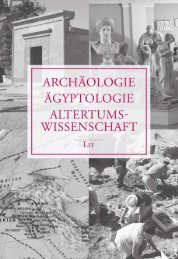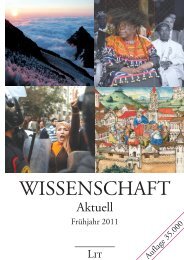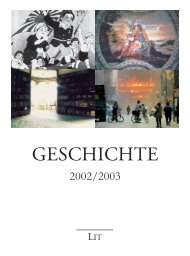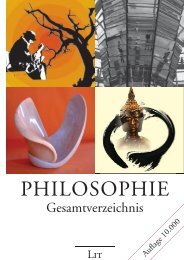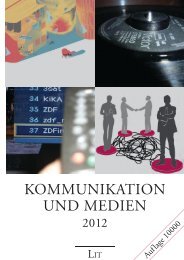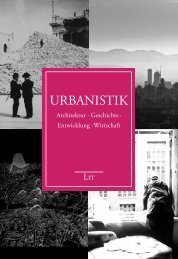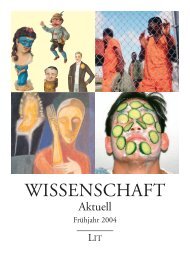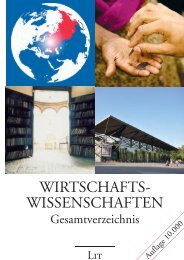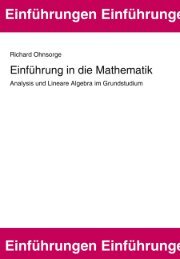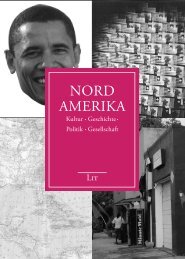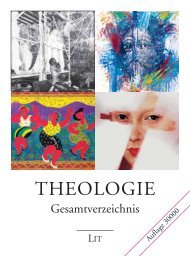Auflage 10000
Auflage 10000
Auflage 10000
Erfolgreiche ePaper selbst erstellen
Machen Sie aus Ihren PDF Publikationen ein blätterbares Flipbook mit unserer einzigartigen Google optimierten e-Paper Software.
Martin Müller<br />
Making Great Power Identities in Russia<br />
This book examines how the discourse of a strong Russia makes geopolitical<br />
subjects at a Moscow elite university. In so doing, it provides an inside<br />
perspective on the education of the future Russian elites and thus, possibly,<br />
on the future directions of Russian foreign policy.<br />
Through the prism of poststructuralist discourse theory this study tries<br />
to think the production of geopolitical identities, applying the work of<br />
theorists like Foucault and Laclau and Mouffe. It finds that what is at the<br />
heart of Russian great power identities is a constitutive lack that makes<br />
for a fundamental ambiguity: articulations of a strong Russia are always<br />
intertwined with the imminent possibility of a weak Russia.<br />
An ethnographic discourse analysis of education at a Russian<br />
elite university<br />
vol. 4, 2009, 256 pp., 24,90 €, pb., ISBN 978-3-643-90010-4<br />
***<br />
Peter Dannenberg<br />
Cluster-Strukturen in landwirtschaftlichen Wertschöpfungsketten<br />
in Ostdeutschland und Polen<br />
Am Beispiel des Landkreises Elbe-Elster und des Powiats Pyrzyce<br />
Wirtschaftsgeographie, Bd. 43, 2007, 240 S., 29,90 €,br.,<br />
ISBN 978-3-8258-0690-3<br />
Johannes Winter<br />
Zwischen Hierarchie und Heterarchie<br />
Kompetenzveränderungen in Tochterbetrieben internationaler<br />
Automobilunternehmen am Standort Polen<br />
Polen zählt zu den wichtigsten Zielregionen für Direktinvestitionen der<br />
Automobilindustrie. Die dort ansässigen Tochterbetriebe ausländischer<br />
Hersteller und Zulieferer werden oft als verlängerte Werkbänke bezeichnet.<br />
Dies missachtet, dass viele Tochterbetriebe über hohe Wertschöpfungsanteile<br />
und Handlungsspielräume verfügen.<br />
Über eine empirisch basierte Unternehmenstypisierung werden Unterschiede<br />
im tochterbetrieblichen Kompetenzportfolio dargelegt. Auch zeigt<br />
sich, dass Tochterbetriebe ihr Kompetenzportfolio aktiv erweitern können<br />
und so zur Heterarchisierung der Konzernstrukturen beitragen.<br />
Wirtschaftsgeographie, Bd. 44, 2009, 240 S., 24,90 €,br.,<br />
ISBN 978-3-8258-1792-3<br />
Andreas Hofer; Klaus Semsroth; Bohdan Tscherkes<br />
Urbane Metamorphosen für die Krim<br />
Stadt- und Raumplanung/Urban and Spatial Planning, Bd. 1, 2005, 184 S.,<br />
14,90 €, br., ISBN 3-8258-9202-6<br />
Susanne Karn<br />
Freiflächen- und Landschaftsplanung in der DDR<br />
Am Beispiel der Werke des Landschaftsarchitekten Walter Funcke<br />
(1907 – 87)<br />
Arbeiten zur sozialwissenschaftlich orientierten Freiraumplanung, Bd. 15,<br />
2005, 336 S., 20,90 €, br., ISBN 3-8258-6039-6<br />
Beachten Sie den Fachkatalog<br />
Geographie<br />
http://www.lit-verlag.de/kataloge<br />
Ethnologie / Anthropologie<br />
ETHNOLOGIE / ANTHROPOLOGIE<br />
Halle Studies in the Anthropology of Eurasia<br />
General Editors: Chris Hann, Thomas Hauschild,<br />
Richard Rottenburg and Burkhard Schnepel<br />
Florian Stammler<br />
Reindeer Nomads Meet the Market<br />
Culture, Property and Globalisation at the ‘End of the Land’<br />
Yamal, translates as the ’end of the land’ in the language of its native Nenets<br />
population. The setting of this anthropological monograph, Yamal<br />
is home to the world’s largest domestic reindeer herds. The region also<br />
accounts for almost 90extraction of huge untapped deposits is now about<br />
to transform vast expanses of tundra pastures into an industrial landscape.<br />
This book gives a valuable insight into nomadic life in the context of<br />
post-Soviet transformation at the onset of gas extraction. Stammler meticulously<br />
analyses relations between reindeer nomads and their social,<br />
political and natural environments, as well as their engagement with the<br />
developing market economy. Their high level of social adaptability is combined<br />
with a sense of belonging to their animals and their land. This study<br />
makes an original and significant contribution to wider debates about nomadic<br />
pastoralism and to anthropological studies of trade, barter, property<br />
and territoriality. The book is also recommended to those with an interest<br />
in background information on the regions that fuel the global economy in<br />
the 21st century.<br />
vol. 6, 2. Aufl. 2009, 408 pp., 29,90 €, pb., ISBN 978-3-8258-8046-0<br />
Vlad Naumescu<br />
Modes of Religiosity in Eastern Christianity<br />
Religious Processes and Social Change in Ukraine<br />
vol. 15, 2008, 272 pp., 29,90 €, pb., ISBN 978-3-8258-9908-0<br />
Stéphanie Mahieu; Vlad Naumescu (Eds.)<br />
Churches In-between<br />
Greek Catholic Churches in Postsocialist Europe<br />
Eastern Rite Catholic Churches occupy an ambiguous position between<br />
two religious worlds and challenge the idea of a sharp religious and political<br />
dichotomy between Eastern and Western Europe. After decades<br />
of repression under socialism, the churches known popularly in Central<br />
Europe as Greek Catholic have successfully undertaken a process of revitalisation.<br />
This has been marked by competition with other churches,<br />
both over material properties and over people’s souls. How can a Greek<br />
Catholic “identity” be recreated? Can these churches provide a distinctive<br />
“product” for the new “religious marketplace”? By exploring such questions<br />
the contributors to this volume shed fresh light on the social and<br />
political shaping of religious phenomena in the era of postsocialism and<br />
also on more general issues of belief, practice, transmission and syncretism.<br />
vol. 16, 2009, 360 pp., 29,90 €, pb., ISBN 978-3-8258-9910-3<br />
Vintilă Mihăilescu; Ilia Iliev; Slobodan Naumovic (Eds.)<br />
Studying Peoples in the People’s Democracies II<br />
Socialist Era Anthropology in South-East Europe<br />
vol. 17, 2008, 472 pp., 29,90 €, pb., ISBN 978-3-8258-9911-0<br />
Krisztina Kehl-Bodrogi<br />
“Religion is not so strong here”<br />
Muslim Religious Life in Khorezm after Socialism<br />
vol. 18, 2008, 272 pp., 24,90 €, pb., ISBN 978-3-8258-9909-7<br />
Ingo W. Schröder; Asta Vonderau (Eds.)<br />
Changing Economies and Changing Identities in Postsocialist<br />
Eastern Europe<br />
This book addresses class formation and changes in personhood in contemporary<br />
Eastern Europe in the context of the spread of a market economy.<br />
The authors investigate processes of social closure, marginalization<br />
and elite formation, paying particular attention to their cultural expressions<br />
and to the legitimizing discourses of nationalist and neoliberal agendas.<br />
While individual and collective identities are inextricably linked with the<br />
consolidation of global capitalism, external blueprints are everywhere mediated<br />
through historically grounded experiences and local social relations.<br />
–14–<br />
Comprising studies from Bulgaria, Latvia, Lithuania, Poland, and Russia,<br />
the volume explores practices, stories, and performances in everyday life<br />
worlds. The ethnographies show both individual and collective identities to<br />
be emergent projects, constrained by economic processes and state policies<br />
but ultimately created by people themselves as they pursue their interests<br />
and search for meaning.<br />
vol. 20, 2009, 256 pp., 29,90 €, pb., ISBN 978-3-8258-1121-1<br />
László Fosztó<br />
Ritual Revitalisation after Socialism<br />
Community, Personhood, and Conversion among Roma in a<br />
Transylvanian Village<br />
vol. 21, 2009, 248 pp., 29,90 €, pb., ISBN 978-3-643-10175-4<br />
Irene Hilgers<br />
Why Do Uzbeks have to be Muslims?<br />
Exploring religiosity in the Ferghana Valley<br />
In this work the late Irene Hilgers analyses the revival of Islam in the public<br />
sphere in postsocialist Uzbekistan, with particular reference to its<br />
role in the construction of a new national identity. Data collected during<br />
fieldwork in 2003-4 are contextualized with reference to the history of the<br />
Kokand Khanate and the suppression of religion during the Soviet era.<br />
Hilgers analyses current state ideology and the official structures for controlling<br />
religion, but also the continued significance of ‘popular religion’,<br />
as expressed at shrines and in healing rituals, and the tensions associated<br />
with ‘Wahabi’ currents. The tight association between Uzbek identity and<br />
Islam is also illustrated through the problems encountered by converts to<br />
Christianity. Throughout the work the author deploys her rich ethnographic<br />
materials to shed fresh light on major debates concerning secularization<br />
and the nature of Soviet and post-Soviet ‘modernity’.<br />
vol. 22, 2009, 192 pp., 29,90 €, pb., ISBN 978-3-643-10176-1<br />
Tommaso Trevisani<br />
Land and Power in Khorezm<br />
Farmers, Communities and the State in Uzbekistan’s Decollectivisation<br />
Process<br />
This first detailed “grass roots” account of Uzbekistan’s protracted decollectivisation<br />
process explores continuity and change in the relations<br />
between rural communities, agricultural producers and local state authorities<br />
in the cotton-growing region of Khorezm. Built up during the Soviet<br />
period, the cotton sector has maintained its importance for the state and<br />
for rural communities in the years after independence, although economic<br />
parameters and social conditions have worsened significantly. Uzbekistan’s<br />
agricultural reform path does not follow that of most postsocialist<br />
scenarios and continuity with the past remains strong. Despite seeming<br />
immobility, the local view on rural society presented in this book unveals<br />
an unexpectedly dynamic situation, characterised by shifts in patronage<br />
relations, struggles over legitimacy, transformations in family structure<br />
and community life. Poised between the state, their communities and an<br />
emerging stratum of absentee farm “sponsors”, the focus of Trevisani’s<br />
analysis is on the new farmers (“fermer”) and their struggles for a place in<br />
rural society. What emerges from decollectivisation is a complexely articulated<br />
new agrarian question: its new inequalities are rooted in the political<br />
economy of cotton.<br />
vol. 23, 2011, 280 pp., 29,90 €, pb., ISBN 978-3-643-90098-2<br />
Lale Yalçın-Heckmann<br />
The Return of Private Property<br />
Rural Life after Agrarian Reform in the Republic of Azerbaijan<br />
What makes private property valuable, desirable, or workable? In this<br />
book, Lale Yalçın-Heckmann focuses on social and economic dimensions<br />
of private property after the agrarian reforms of 1996 in Azerbaijan. She<br />
looks at the kinds of land and cultivation strategies emerging in the decades<br />
after the fall of the Soviet Union and asks why rural households are<br />
often unwilling to cultivate the privatised land shares they have received<br />
for free, despite the threat and existence of rural poverty. Consideration is<br />
given to households that engage in cultivation and households that do not –<br />
including households of internally displaced persons who were formally<br />
excluded from privatisation but were nevertheless successful and eager<br />
cultivators. The author asks, how far does private property thrive on its<br />
own, without the support of lucrative markets or the implementation of<br />
state-sponsored economic policies? Through the lens of economic anthropology<br />
she chronicles the historical legacy of authoritarian state structures<br />
and the contemporary micro- and macro-economic struggles that mark a<br />
politics of property after socialism.<br />
vol. 24, 2011, 240 pp., 29,90 €, pb., ISBN 978-3-643-10629-2



